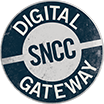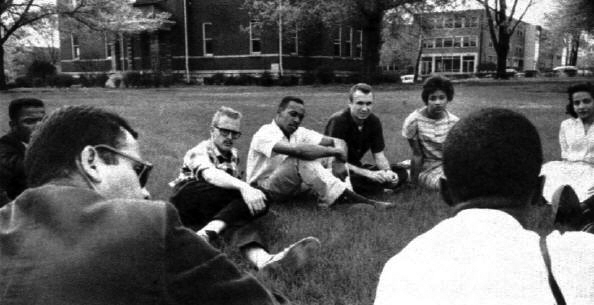Fall 1959
Jim Lawson conducts nonviolence workshops in Nashville
Until Ohio native and pacifist Reverend James M. Lawson put the idea before them, nonviolence as a way to struggle was not in the minds of any of the students attending HBCUs in Nashville, Tennessee and who would become leaders of SNCC. In 1959, Lawson was enrolled at Vanderbilt University’s Divinity School when a local woman confronted him: “You men don’t really know what life is like in segregation. We are the ones who shop … So as we do your shopping for you, you’re in … your own offices and the like, but we’re the ones who bear the brunt of the racism of the segregation in Nashville.” This–what was essentially a challenge–motivated Lawson to begin workshops on nonviolence with the idea of launching direct action against segregation in Nashville.
Lawson, though a northerner, was very much aware of segregation and other forms of white supremacy in the South. Just a year earlier, he had organized workshops for the Nashville Christian Leadership Council, on behalf of the Fellowship of Reconciliation. Lawson’s teachings attracted many of Nashville’s young students because his principles were more radical than more moderate civil rights activists. He taught nonviolence as both a theory and a practice, believing, as he told students at SNCC’s founding conference, that sit-ins were “a judgment upon middle-class conventional, half-way efforts to deal with radical social evil with also a religious ideal.”
Students like Diane Nash, John Lewis, Bernard Lafayette, C.T. Vivian, and Jim Bevel were all attracted to Lawson’s workshops. They felt humiliated and confined by Jim Crow laws and felt that to obey the laws meant that they agreed with the idea of Black inferiority. Lawson’s workshops offered a way to fight.
The workshops began by teaching students the theory and philosophy behind nonviolence. Then, they began practicing a variety of nonviolent tactics and how to respond when confronted with violence. They could be intense, C.T. Vivian recalled, involving “how to in fact begin to take the blows–cigarettes put out on you, the fact that you were being spit on–and still, still respond with some sense of dignity and with a loving concept of what you were about, to be hit and to be knocked down, and to understand that in terms of struggle, and in terms of reaching conscience, in terms of, of gaining the greater goals for which are sought.”
They began testing nonviolence in downtown Nashville even before the Greensboro sit-ins erupted. Following the workshops, Nashville students attempted to talk with local restaurant owners about desegregating their businesses. As Nash remembered, “They listened, and then they said, ‘Does this complete your presentation?’ There were four or five of us, and we said yes. And the person who was serving as their spokesperson said, ‘Well thank you very much. We have to get back to work.’”
A photograph of silent protesters in Nashville, Tennessee, April 19, 1960, Nashville Public Library Digital Collection
One reason local owners resisted desegregation was fear that white people would boycott their restaurants if Black people were allowed to use their lunch counters. The young activists informed merchants that they had recruited some white supporters, and they had agreed to sit with them at the lunch counter. “As long as those white ladies were sitting there at the newly desegregated lunch counter,” Diane Nash remembered, “there could not be a boycott by white people, and that worked very well.” In practice, however, the city remained segregated.
It was through these workshops that Nashville’s students developed nonviolence as not only a tactic, but also as a way of life. Nash credited Lawson and his workshops with giving her “a really good, excellent education in nonviolence” that forever shap[ed] the kind of person [she’d] become.”
The Nashville students developed some of SNCC’s strictest rules for demonstrations: “Don’t strike back or curse if abused … Show yourself courteous and friendly at all times…Report all serious incidents to your leader in a polite manner. Remember love and nonviolence.”
Sources
Clayborne Carson, In Struggle: SNCC and the Black Awakening of the 1960s (Cambridge, MA: Harvard University Press, 1996).
David Halberstam, The Children (New York: Random House, 1998).
John Lewis with Michael D’Orso, Walking With the Wind: a Memoir of the Movement (San Diego: Harcourt Brace and Company, 1999).
Howard Zinn, SNCC: the New Abolitionists (Boston: Beacon Press, 1964).





